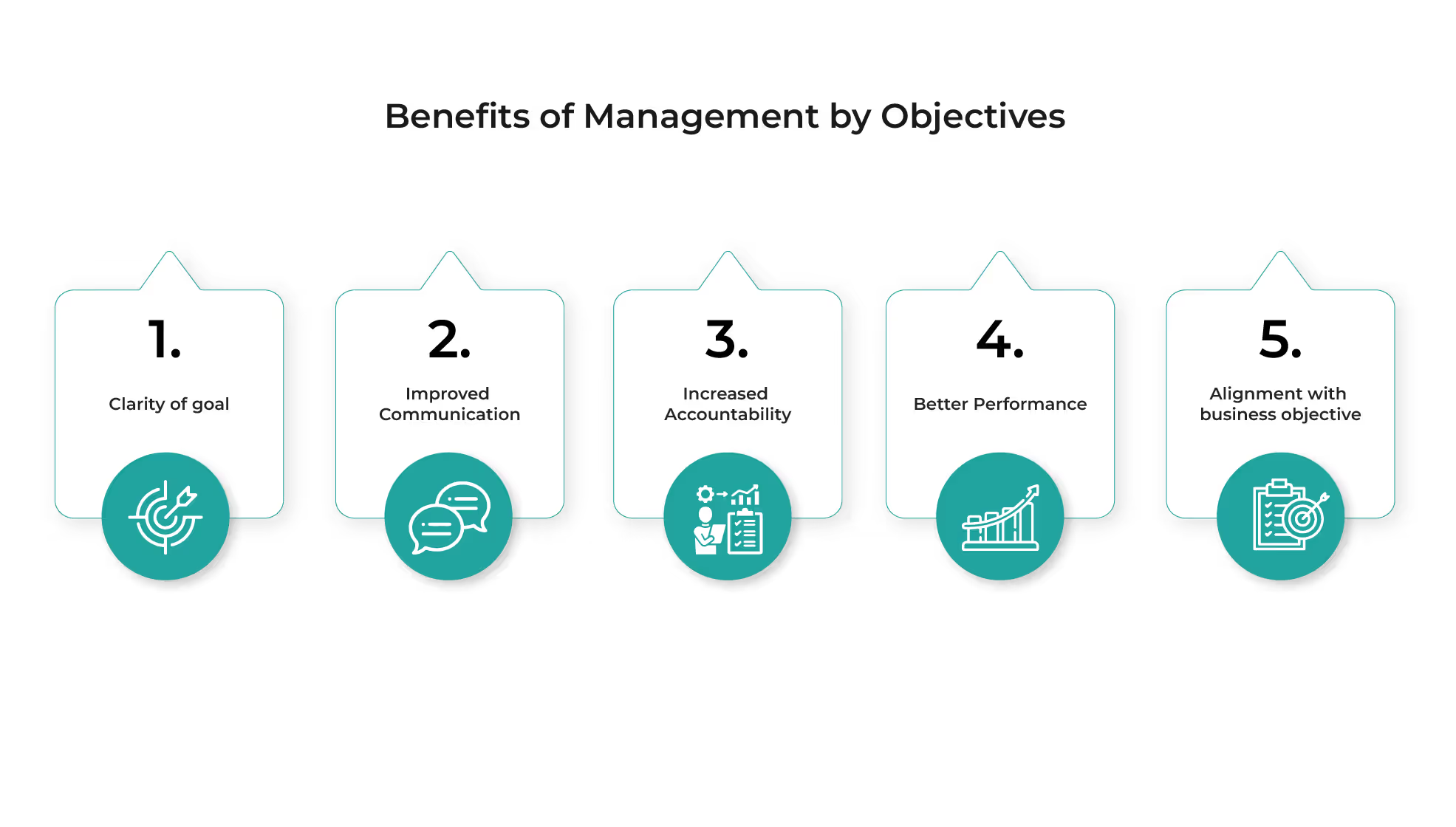
Blog
Understanding Management by Objectives (MBO)
October 17, 2022


Key Insights
When Peter Drucker coined the term MBO in his 1954 book titled The Practice of Management, little did he know that it would cause such a stir in the world of management. It is easy to understand the enthusiasm.
On paper, MBO makes a lot of sense!
The pivot of any business are its employees. Therefore, when Drucker suggested that involving them in setting business goals means they are more likely to share top management’s objectives, it was as if the Pandora’s box was suddenly opened and all these questions that were otherwise embedded in the silos of old management practices were suddenly out in the open.
But, what is MBO? Read more to find out!
What is Management by Objectives (MBO)?
To put it simply, Management by Objectives is a performance-based reward system in which managers and employees work in collaboration to set goals.
The genius of Drucker is commendable. Instead of coming up with complex management mantras, he set forth several easy principles that management could follow-
- Objectives are laid out on an individual basis by the management and the employee
- These objectives should be challenging but achievable
- Employees should ideally receive daily feedback
- The focus is on rewards rather than punishment
- Personal growth is emphasized
The aim of MBO is to align targets with the organization’s objectives, and team members earn based on how effectively they complete the goals defined in their individual MBO program.
Each employee's MBO plan should clearly define their tasks, workflows, and the role they play in various sales channels examples, ensuring that these goals are emphasized from day one.
While MBO looks perfect on paper, its performance has been skewed, particularly in relation to sales compensation plans. A weakness pointed out by many critics is that this management style tends to emphasize goal-setting for objectives but often lacks a comprehensive sales compensation plan to effectively align incentives or a clear playbook for sales team.
Prominent critics of the theory, such as W. Edwards Deming, argue that ‘setting particular goals like production targets leads workers to meet those targets by any means necessary, including shortcuts that result in poor quality.’
Therefore, streamlining the process of introducing MBO and following best practices becomes a top priority for most players.

So, is MBO right for your business? Ask yourself
- Do you have a clear vision for your business?
- Are your employees motivated and ready to take ownership of their goals?
- Are you willing to invest time and effort in making MBO work?
If you answered "yes" to these questions, MBO could be a game-changer. But remember, every business is unique. What works for one might not work for another.
A step-by-step guide for MBO optimization:
MBO optimization cannot be achieved overnight! Refer to these easy-to-follow steps that we’ve put together for you-
- Revise the organizational objectives for the entire company, incorporating the sales pipeline funnel as a vital component. This comprehensive overview should reflect the company's mission and vision, while also outlining strategic goals for optimizing the sales process and driving revenue growth.
- Translate the organizational objectives to employees. In 1981, George T. Doran used the acronym SMART (specific, measurable, acceptable, realistic, time-bound) to express the concept.
- Stimulate the participation of employees in setting individual objectives. After the organization’s objectives are shared with employees from the top to the bottom, employees should be encouraged to help set their own objectives to achieve these larger organizational objectives. This gives employees greater motivation since they have greater empowerment.
- Monitor the progress of employees. In step two, a key component of the objectives was that they are measurable for employees and managers to determine how well they are met.
- Learn how the incentive theory of motivation can enhance these efforts. Check The Incentive Theory of Motivation: Exploring, Implementing, Types.
Benefits of Management by Objectives:
The benefits of MBO include:

- Clarity of Goals: MBO helps to establish clear and measurable goals that are aligned with the overall objectives of the organization. This helps to create a sense of direction and purpose for employees, and ensures that everyone is working towards the same targets.
- Improved Communication: MBO requires regular communication between managers and employees, which helps to build stronger relationships and promotes open communication channels. This helps to foster trust and transparency, which in turn can improve employee morale and engagement.
- Increased Accountability: MBO helps to establish clear expectations for employee performance and provides a framework for holding employees accountable for meeting their objectives. This can help to create a culture of accountability, where employees take ownership of their work and strive to achieve their goals.
- Better Performance: MBO helps to improve employee performance by providing regular feedback and coaching on progress towards objectives. This helps employees to identify areas for improvement and to make adjustments to their work processes to achieve better results.
- Alignment with Business Objectives: MBO helps to align employee goals and objectives with the overall objectives of the organization, which can improve overall business performance. When everyone is working towards the same goals, the organization can achieve greater success and growth.
Overall, MBO can help organizations to improve communication, increase accountability, and achieve better results by setting clear goals and working collaboratively towards achieving them.

Disadvantages of Management by Objectives:
While MBO can be an effective approach to management, there are also some disadvantages to consider:

- Time-consuming: Implementing MBO can be a time-consuming process. It requires a significant investment of time and resources to set objectives, define tasks, and measure progress towards achieving those objectives.
- Focus on short-term objectives: MBO can sometimes result in a focus on short-term objectives at the expense of long-term goals. This is because MBO emphasizes the achievement of specific objectives within a certain time frame, which may not always align with the long-term strategic goals of the organization.
- Emphasis on quantifiable objectives: MBO emphasizes the need for objectives to be measurable and quantifiable. While this can be useful in some contexts, it may not be appropriate for all types of objectives. Some objectives, such as those related to employee satisfaction or creativity, may be more difficult to quantify.
- Potential for goal displacement: MBO can sometimes lead to goal displacement, where employees focus solely on achieving the objectives that have been set for them, rather than pursuing other important goals or tasks that may not be explicitly defined in the MBO process.
- Overemphasis on individual performance: MBO can sometimes lead to an overemphasis on individual performance at the expense of teamwork and collaboration. This can be particularly problematic in organizations where teamwork is critical to achieving success.
- Resistance to change: MBO can sometimes create resistance to change, particularly if employees feel that the objectives, coupled with individual incentives, are unrealistic or unattainable. This can result in a lack of buy-in from employees and hinder the achievement of desired outcomes.
It is important to be aware of its potential disadvantages and to use it in a way that is appropriate for the specific context and goals of the organization.
MBO: Red Flags
- As MBO primarily emphasizes goals and targets, it often overlooks other vital elements within a company, such as cultivating a positive culture of conduct, fostering a healthy work ethos, and creating opportunities for involvement, contribution, and fair allocation of sales commissions.
- Strain is increased on employees to meet the goals in a specified time frame.
- Employees are encouraged to meet targets by any means necessary, meaning that shortcuts could be taken and the quality of work compromised.
- If management solely relies on MBO for all management responsibilities, it can be problematic for areas that don’t fit under MBO.
Level Up Your MBO Game: Tips for Success
MBO can be a powerful tool, but it's not always a slam dunk. Here are a few tips to help you maximize its effectiveness:
Make it SMART (Specific, Measurable, Achievable, Relevant, Time-bound)
- Quantify your success: How will you know when you've reached your goal?
- Set the bar right: Goals should be challenging but attainable.
- Stay aligned: Ensure your goals contribute to your overall business strategy.
- Deadlines matter: Set specific timelines to keep everyone on track.
Involve Your Team
- Collaborative goal-setting: Let your team have a say in the goals they're working towards.
- Regular check-ins: Schedule regular meetings to discuss progress and address any roadblocks.
- Feedback is a gift: Encourage open and honest feedback to help your team improve.
Flexibility is Key
- Adapt as needed: Be prepared to adjust your goals as circumstances change.
- Celebrate small wins: Recognize and reward progress, even if it's towards a smaller milestone.
Tie it to Rewards
- Sweeten the deal: Offer incentives or rewards for achieving goals.
- Recognize effort: Even if a goal isn't fully met, acknowledge the hard work put in.
Remember, MBO is a journey, not a destination. By following these tips, you can create a culture of goal-setting, accountability, and continuous improvement.
Your Edge: Automation with Kennect!
A Management by objective program should be diverse and dynamic, and chances are that your employees will spend too much time writing emails and spreadsheets.
Kennect’s fully automated ICM solution leverages a data-driven approach to build, run and automate your incentive compensation plans to create transparency and achieve operational efficiency. This provides uniformity across all departments and sales regions, streamlines operations and practically eliminates the risk of human error impacting remuneration.
Book a demo with us today to learn more about how Kennect can help you optimize your MBO plans!
ReKennect : Stay ahead of the curve!
Subscribe to our bi-weekly newsletter packed with latest trends and insights on incentives.
Thank you! Your submission has been received!
Oops! Something went wrong while submitting the form.
Your data is in safe hands. Check out our Privacy policy for more info






.avif)








